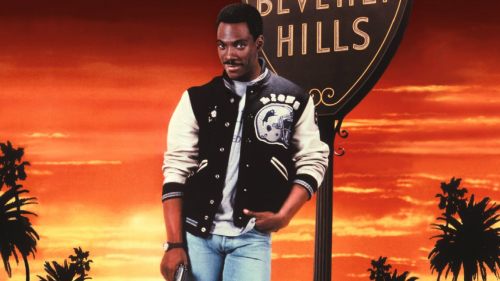The Moore, The Merrier: Director Craig Brewer On “DOLEMITE IS MY NAME”
According to director Craig Brewer, there are two kinds of people in the world: Those who know of Rudy Ray Moore, his trendsetting comedy and his cult-favorite Dolemite character, and those who don’t. With Dolemite Is My Name, which premieres on Netflix Friday and stars Eddie Murphy as Moore, Brewer is hoping to tip the scales a bit in favor of the former.
“The joyous thing I discovered when we were testing the movie,” Brewer recalls, “is that maybe one-quarter of the audience knew who Rudy Ray Moore was—and they got angry at the other three-quarters who didn’t! Like, ‘How do you not know who he was?’ At that point, I realized that maybe we had something special here, because everybody enjoyed the film, they got into it, but many of them didn’t know anything about the man. Hopefully we’ve made an entertaining and pleasing movie but have also contributed to righting a wrong, since more people need to know about Rudy, his story and what he did.”
What Moore did, as chronicled in Dolemite Is My Name, was rise above a background of poverty and an unsuccessful stint as a singer, adapting the street rap of his Los Angeles neighborhood into a standup act that became a hit on the comedy circuit in the 1970s. It was the first step in a DIY career that continued with the self-produced/distributed first of several albums, and then pulling together a group of pals and acquaintances to create a screen vehicle for his rhyming pimp. Dolemite eventually met with box-office success and enduring popularity on video, but Moore struggled long and hard to make it and then get it into theaters—an experience that Brewer could identify with.
“I started off in Memphis, Tennessee,” he explains, “with a ragtag group of friends who worked at the bookstore with me, and at local bars and strip clubs, and we said, ‘Hey, let’s make a movie on the streets of Memphis.’ It was called The Poor & Hungry; we didn’t have permits, we didn’t have any money, we had amateur actors, but we put our hearts and souls into it. So many times, things would step in our way, and there were all these soul-crushing nights when I was like, ‘Why am I doing this? Why am I putting so much into this?’ And that movie finally won a Hollywood Film Festival award, and by then I had written a sequel to it, which was Hustle & Flow.”
Brewer’s 2005 drama about a pimp aspiring to become a rapper earned star Terrence Howard an Academy Award nomination, and featured the first African-American hip-hop song to win an Oscar: Three 6 Mafia’s “It’s Hard Out Here for a Pimp.” Thus it’s rather appropriate for the director to tell the story of a man who took some of the first steps bringing rap off the streets and pointing it toward the mainstream. “I’ve thought that in a sense, Hustle & Flow is a good follow-up to Dolemite Is My Name, even though I made Dolemite more than a decade later, because they’re spiritual brothers to some extent. Both are about experiencing some of the same things. Rudy Ray Moore inspired a lot of rap artists, and hopefully his struggle will also inspire a lot of current rappers to stay with it, to keep going.”
Brewer had been a longtime fan of Moore before Scott Alexander and Larry Karaszewski’s Dolemite Is My Name script came his way, discovering him first through his films. “There were a handful of blaxploitation movies I would watch over and over again—Truck Turner, Black Samson, The Mack. But Dolemite was the one that, for whatever reason, had the lines that me and my friends would always say to each other. There were so many glorious flaws in the movie, but at the same time, you had to respect his bravado in performing Dolemite. I also collect a lot of vinyl, and Rudy had some of the best album covers ever, because they’ve got all these naked people on them, but at the same time they’re funny. And then Larry and Scott had done so much research, it was just great to dive into their script and learn so much more about how these movies got made.”
Originally, Alexander and Karaszewski had covered the breadth of Moore’s career, and over the course of development, they and Brewer managed to narrow the focus while still delivering the full Rudy Ray Moore experience. “All the details about him making Dolemite are true,” the director notes, “though we took some of the scenes from [the sequel] The Human Tornado. Larry and Scott and I had some long debates as to whether to use scenes from other movies here and there, and we ultimately came to the realization that we were telling the Rudy Ray Moore story, and wanted to give people the full range of what he was in entertainment, though it ends with the victory of Dolemite coming out.”
Murphy, who initiated the project before Moore’s death in 2008, and Brewer worked closely to create a fully rounded portrait of the man. “I wasn’t worried about Dolemite—he’s larger than life—but I wanted to make sure Eddie was down with showing Rudy being vulnerable, being insecure,” the director says. “And also, showing audiences something we don’t really get to see Eddie Murphy do, which is go through the process of creating the perfect act. We usually just see the end result, but in this movie we wanted to celebrate Rudy putting it all together.” Murphy uses his real voice in the role instead of attempting to approximate Moore’s, which Brewer believes was the right choice. “It’s always better to move the role toward the actor. The same could be said if someone was playing Dr. King or another iconic role; you can do your best, but you’re never going to sound exactly like them. So I told Eddie to bring Rudy more around to him than the other way around, because we weren’t here to do an impersonation contest.”
That went double when it came to Wesley Snipes, who steals his scenes as D’Urville Martin, the more experienced actor Moore convinced to appear in Dolemite by offering him the director’s chair. Snipes hilariously plays Martin as a preening narcissist, which may be an exaggeration, but sure works for the film. “We had a lot of information about how D’Urville Martin was kind of a big-time actor among all these guys who didn’t have any credits, but he still played the elevator operator in Rosemary’s Baby, so he was dealing with his own pigeonholing. We also knew from Nicholas von Sternberg, who shot Dolemite [and is played in Brewer’s movie by Kodi Smit-McPhee], that D’Urville was a bit drunk during some of the filming of Dolemite; in some cases, he would even direct from the floor. Wesley just ran with that, and I’ll tell you, I think he’s electrifying in the movie.”
Brewer and co. did aim for as much authenticity as possible in recreating Moore’s production of Dolemite, even shooting at some of the same locations Moore used, like the house outside of which the title character shows off his negligible kung fu skills. They weren’t able to use the Dunbar Hotel—a hub of the LA jazz scene in the 1930s and ’40s that was abandoned when Moore utilized it as Dolemite’s home base—“though we shot nearby,” Brewer says. “We went to the Dunbar, but now it’s partially a home for the elderly, and they only have one elevator, so logistically it would have been difficult.” And of all the Dolemite moments they recreated for the biopic, “The one I’m most proud of is that glorious sex scene,” which Moore played for over-the-top laughs, with even the wall hangings getting into the act. “I’ve had to do some sex scenes in my career,” Brewer says, “and nothing’s going to top the sex scene in Dolemite Is My Name. Ever.”
So we’ll have await other highlights in his next film, Coming 2 America, the sequel that reunites him with Murphy and Snipes. According to Brewer, Murphy has had no problems stepping back into the robes of Prince Akeem of Zamunda more than 30 years after the hit original. “It just takes him getting into those costumes and being around Arsenio Hall [returning as Akeem’s friend Semmi], and he’s right back in it. What’s really fun about Coming 2 America is, he can’t be the exact same Akeem. That Akeem was 30 years younger and his whole life was ahead of him; now he’s going to be king, and he’s got more troubles. It’s also fun that a lot of it takes place in Zamunda; they do come to America, but they all have to go right back to Africa! We’re in the middle of filming right now; it’s going fantastic, and I think people are going to be happy with what we’re making for them.”



